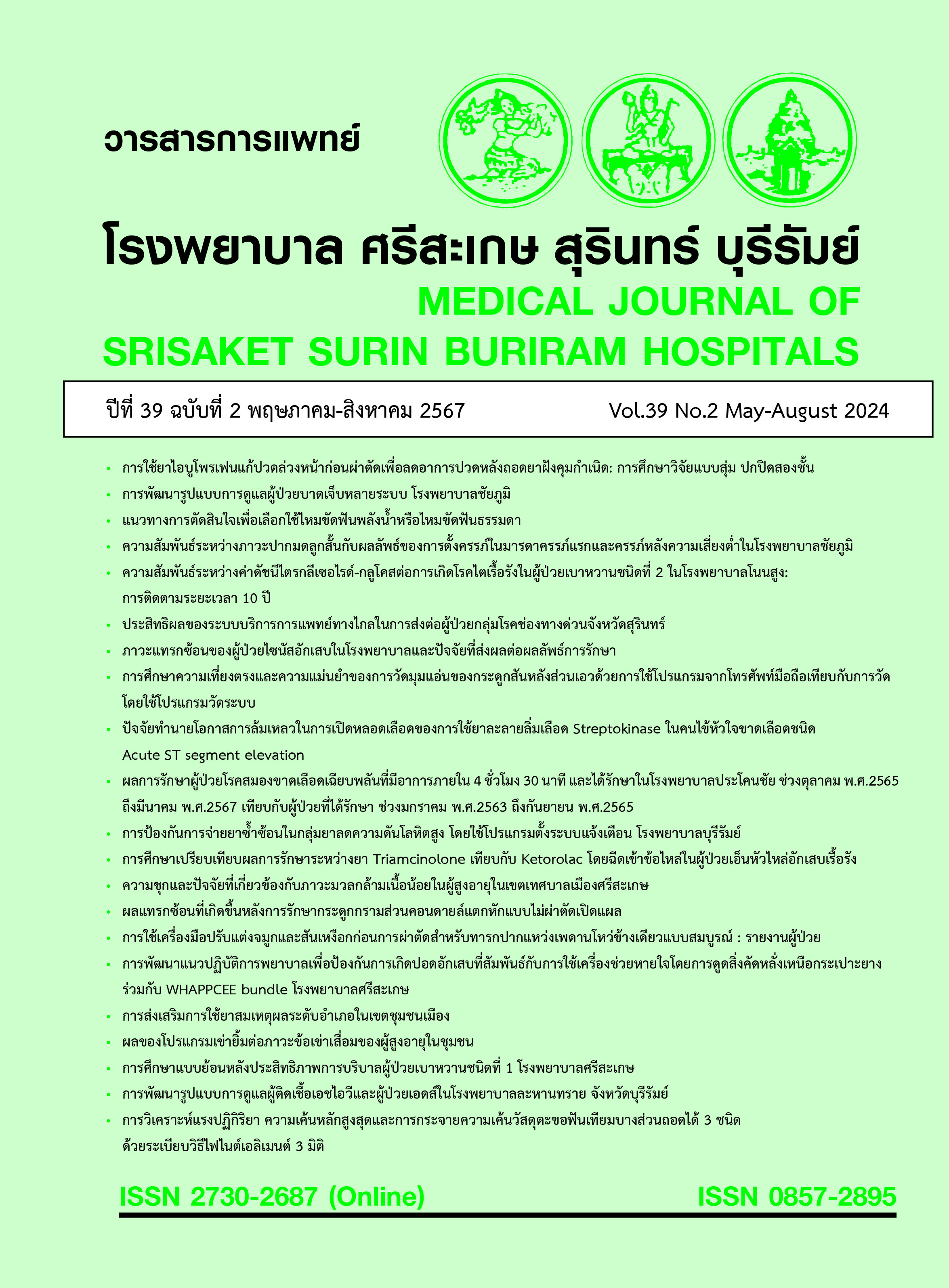การวิเคราะห์แรงปฏิกิริยา ความเค้นหลักสูงสุดและการกระจายความเค้นวัสดุตะขอฟันเทียมบางส่วนถอดได้ 3 ชนิดด้วยระเบียบวิธีไฟไนต์เอลิเมนต์ 3 มิติ
Main Article Content
บทคัดย่อ
หลักการและเหตุผล: อะซีตอลเรซินและพีอีอีเคมีแนวโน้มที่ถูกนำมาทำตะของานฟันเทียมบางส่วนถอดได้มากขึ้น สิ่งที่ทันตแพทย์ต้องพิจารณาก่อนจะเลือกใช้วัสดุคือแรงปฏิกิริยา ความเค้นหลักสูงสุด และการกระจายความเค้นที่เกิดขึ้นเมื่อตะขอได้รับแรงโดยเฉพาะแรงจากการถอดใส่ฟันเทียม
วัตถุประสงค์: วิเคราะห์แรงปฏิกิริยา ความเค้นหลักสูงสุดและการกระจายความเค้นที่เกิดขึ้นของวัสดุทำตะขอโคบอลต์โครเมียม อะซิตอลเรซิน และพีอีอีเคที่มีอัตราส่วนความสอบและระยะการกดต่างกันด้วยวิธีระเบียบไฟไนต์เอลิเมนต์
วิธีการศึกษา: สร้างโมเดล 3 มิติของตะขอยาว 15 มม.ส่วนของโคนตะขอกว้าง 2 มม.และหนา 1.5 มม. และสร้างส่วนปลายให้มีอัตราส่วนความสอบแตกต่างกันคือ 0.6 0.8 และ 1 กดตะขอที่จุดห่างปลายตะขอ 3 มม.ที่ระยะ 0.5 1.0 และ 2.0 มม. วิเคราะห์ด้วยวิธีระเบียบไฟไนต์เอลิเมนต์เพื่อหาแรงปฏิกิริยา ความเค้นหลักสูงสุดและการกระจายความเค้น
ผลการศึกษา: แรงปฏิกริยาเพิ่มขึ้นตามอัตราส่วนความสอบของตะขอที่เพิ่มขึ้นและตามระยะการกดที่เพิ่มขึ้นในทุกวัสดุ เรียงลำดับจากมากสุดไปน้อยสุดคือโคบอลต์โครเมียม พีอีอีเค และอะซีตอลเรซินตามลำดับ สำหรับความเค้นหลักสูงสุดพบว่าสูงขึ้นตามอัตราส่วนความสอบและสูงขึ้นตามระยะการกดในทุกวัสดุ โดยเรียงลำดับจากมากสุดไปน้อยสุดคือโคบอลต์โครเมียม พีอีอีเค และอะซีตอลเรซินตามลำดับ ซี่งพบว่าทุกกลุ่มของโคบอลต์โครเมียมให้ค่ามากกว่าค่าความเค้นคราก สำหรับรูปแบบการกระจายความเค้นพบว่าทุกกลุ่มไม่แตกต่างกันคือมีความเค้นสะสมอยู่ที่บริเวณส่วนโคนของตะขอ
สรุป: พีอีอีเคและอะซีตอลเรซินนั้นสามารถเป็นวัสดุทางเลือกสำหรับการทำตะของานฟันเทียมบางส่วนถอดได้โดยการเพิ่มขนาดตะขอและใช้ในฟันหลักที่มีความคอดมากกว่า
Article Details

อนุญาตภายใต้เงื่อนไข Creative Commons Attribution-NonCommercial-NoDerivatives 4.0 International License.
เอกสารอ้างอิง
Faurschou A, Menné T, Johansen JD, Thyssen JP. Metal allergen of the 21st century--a review on exposure, epidemiology and clinical manifestations of palladium allergy. Contact Dermatitis 2011;64(4):185-95. doi: 10.1111/j.1600-0536.2011.01878.x.
Chen J, Cai H, Suo L, Xue Y, Wang J, Wan Q. A systematic review of the survival and complication rates of inlay-retained fixed dental prostheses. J Dent 2017;59:2-10. doi: 10.1016/j.jdent.2017.02.006.
Jamari J, Ammarullah MI, Santoso G, Sugiharto S, Supriyono T, van der Heide E. In Silico Contact Pressure of Metal-on-Metal Total Hip Implant with Different Materials Subjected to Gait Loading. Metals 2022;12(8):1241. https://doi.org/10.3390/met12081241
Pious CV, Thomas S. 2 - Polymeric Materials—Structure, Properties, and Applications. In: Izdebska J, Thomas S, editors. Printing on Polymers Fundamentals and Applications. Amsterdam : Elsevier Inc ; 2016 : 21-39.
Corrente G, Vergnano L, Pascetta R, Ramadori G. A new custom-made abutment for dental implants: a technical note. Int J Oral Maxillofac Implants 1995;10(5):604-8. PMID: 7591006
Singh K, Aeran H, Kumar N, Gupta N. Flexible thermoplastic denture base materials for aesthetical removable partial denture framework. J Clin Diagn Res 2013;7(10):2372-3. doi: 10.7860/JCDR/2013/5020.3527.
Turner JW, Radford DR, Sherriff M. Flexural properties and surface finishing of acetal resin denture clasps. J Prosthodont 1999;8(3):188-95. doi: 10.1111/j.1532-849x.1999.tb00034.x.
Osada H, Shimpo H, Hayakawa T, Ohkubo C. Influence of thickness and undercut of thermoplastic resin clasps on retentive force. Dent Mater J 2013;32(3):381-9. doi: 10.4012/dmj.2012-284.PMID: 23718997
Aly Sadek S, Dehis WM, Hassan H. Comparative Study Clarifying the Most Suitable Material to Be Used as Partial Denture Clasps. Open Access Maced J Med Sci 2018;6(6):1111-9. doi: 10.3889/oamjms.2018.226.
A.Helal M, Abd-Elrahman IA, Saqar HM, Salah A, Abas M. Evaluation of Acetal Resin and Cobalt–Chromium Clasp Deformation and Fatigue Resistance in Removable Partial Denture Clasps - An In Vitro Study. Clinical Research in Dentistry 2018;1(1):1-5. DOI:10.33309/2639-8281.010102
Najeeb S, Zafar MS, Khurshid Z, Siddiqui F.Applications of polyetheretherketone (PEEK) in oral implantology and prosthodontics. J Prosthodont Res 2016;60(1):12-9. doi:10.1016/j.jpor.2015.10.001.
Rahmitasari F, Ishida Y, Kurahashi K, Matsuda T, Watanabe M, Ichikawa T.PEEK with Reinforced Materials and Modifications for Dental Implant Applications. Dent J (Basel) 2017;5(4):35. doi: 10.3390/dj5040035.
Ichikawa T, Kurahashi K, Liu L, Matsuda T, Ishida Y. Use of a Polyetheretherketone Clasp Retainer for Removable Partial Denture: A Case Report. Dent J (Basel) 2019;7(1):4. doi: 10.3390/dj7010004.
Peng TY, Ogawa Y, Akebono H, Iwaguro S, Sugeta A, Shimoe S. Finite-element analysis and optimization of the mechanical properties of polyetheretherketone (PEEK) clasps for removable partial dentures. J Prosthodont Res 2020;64(3):250-6. doi: 10.1016/j.jpor.2019.07.012.
Frank RP, Nicholls JI. A study of the flexibility of wrought wire clasps. J Prosthet Dent 1981;45(3):259-67. doi: 10.1016/0022-3913(81)90386-3.
Soo S, Leung T. Hidden clasps versus C clasps and I bars: a comparison of retention. J Prosthet Dent 1996;75(6):622-5. doi: 10.1016/s0022-3913(96)90247-4.
Helal MA, Baraka OA, Sanad ME, Ludwig K, Kern M. Effects of long-term simulated RPD clasp attachment/detachment on retention loss and wear for two clasp types and three abutment material surfaces. J Prosthodont
;21(5):370-7. doi: 10.1111/j.1532-849X.2012.00844.x.
Ravindra KA, Dayalan M. A Comparative Evaluation of Stress Distribution, Deformation and Retentive Force of Three Different Partial Denture Framework in Two Removable Partial Denture Designs: A Finite Element Analytical Study. Int j innov 2023;8(2):1357-65. doi: https://doi.org/10.5281/zenodo.7691914
Fitton JS, Davies EH, Howlett JA, Pearson GJ. The physical properties of a polyacetal denture resin. Clin Mater 1994;17(3):125-9. doi: 10.1016/0267-6605(94)90135-x.
Tannous F, Steiner M, Shahin R, Kern M. Retentive forces and fatigue resistance of thermoplastic resin clasps. Dent Mater 2012;28(3):273-8. doi: 10.1016/j.dental.2011.10.016.
Urano S, Hotta Y, Miyazaki T, Baba K. Bending properties of Ce-TZP/A nanocomposite clasps for removable partial dentures. Int J Prosthodont 2015;28(2):191-7. doi: 10.11607/ijp.4113.
Vaddamanu SK, Alhamoudi FH, Chaturvedi S, Alqahtani NM, Addas MK, Alfarsi MA, et al. Retentive Forces and Deformation of Fitting Surface in RPD Clasp Made of Polyether-Ether-Ketone (PEEK). Polymers (Basel) 2023;15(4):956. doi: 10.3390/polym15040956.
Bates JF. The mechanical properties of the cobalt-chromium alloys and their relation to partial denture design. Br Dent J 1965;119(9):389-96. PMID: 5215087
Ghani F, Mahood M. A laboratory examination of the behaviour of cast cobalt-chromium clasps. J Oral Rehabil 1990;17(3):229-37. doi: 10.1111/j.1365-2842.1990.tb00003.x.
Kotake M, Wakabayashi N, Ai M, Yoneyama T, Hamanaka H. Fatigue resistance of titanium-nickel alloy cast clasps. Int J Prosthodont 1997;10(6):547-52. PMID: 9495176


